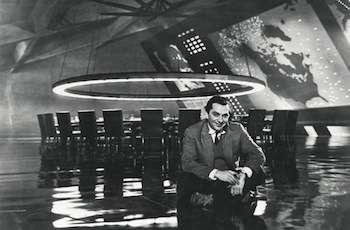Ken Adam

Ken Adam is a legendary production designer and art director, whose film credits include Dr. Strangelove and seven James Bond films. A German Jew born in Berlin in 1921, Adam left Germany at age 12 after Adolf Hitler took over. He arrived in England where he studied architecture and served in the Royal Air Force during WWII. In 1947, Adam entered the British film industry as an assistant art director on such period pictures as Captain Horatio Hornblower (1950) and Helen Of Troy (1956). He was a full art director for the European-filmed sequences of Mike Todd's Around the World in Eighty Days (1956) and became a production designer in 1960. He worked on The Trials Of Oscar Wilde produced by Albert "Cubby" Broccolli. Two years later, Broccolli hired him to work on the first James Bond film, Dr. No (1962). Inspired by both German Expressionism and the modernist architecture of Frank Lloyd Wright, Adam succeeding in giving a multimillion-dollar veneer to what was a very economical production. His imaginative work in that film caught the attention of director Stanley Kubrick. Kubrick enlisted him for his production of his nuclear war comedy Dr. Strangelove (Or How I Stopped Worrying And Love The Bomb (1964). His "War Room" remains one of the most memorable sets ever seen on film. In Goldfinger (1964), the story's climax takes place inside the U.S. gold depository at Fort Knox. Adam was denied access to the Fort's actual interior, and had to conjure up the contours of the vault from his own imagination. His version of Fort Knox was a "Cathedral of Gold" with stacks and stacks of gold bars. Adam remained with the Bond series until the 1970s, his budget (and his creativity) expanding with each successive feature. In 1975, Adam won an Academy Award for his re-creation of 18th century England in Kubrick's Barry Lyndon, and in 1981 he was given "visual consultant" credit for designing a vast Edward Hopper-style cityscape in Herbert Ross' Pennies From Heaven (1991). Among Ken Adams' other most notable achievements has been his brilliant literalization of the creepy cartoon world of Charles Addams in 1993's Addams Family Values. Ken Adam received his second Oscar in 1994 for The Madness of King George.